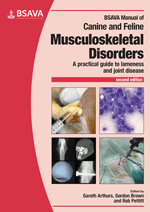
Full text loading...

This chapter covers anatomy, diagnosis and treatment of conditions of the distal limb, including surgical preparation, external coaptation, metacarpophalangeal and metatarsophalangeal joint injury, conditions of the palmar and volar sesamoid bones, the proximal and distal interphalangeal joint, tendon injuries, conditions of the digital pads and integument of the paw, infection of the paw. Includes Quick Reference Guide to Imaging Techniques by Thomas W. Maddox. Operative Techniques: The application of a digital external skeletal fixator; Amputation of the digit; Ungual crest ostectomy (permanent nail removal); Distal digit (phalanx 3) ostectomy; Incisional and excisional separation podoplasty; Corn excision; Sesamoidectomy.
The distal limb, Page 1 of 1
< Previous page | Next page > /docserver/preview/fulltext/10.22233/9781910443286/9781910443286.21-1.gif

Full text loading...








































